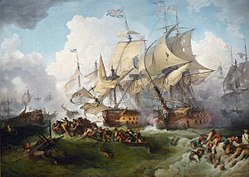A half-length full-face portrait within a painted circle. The sitter wears admiral's undress uniform, 1787-95, of a blue jacket with gold braid and his own white hair.
On 1 June 1794, in command of the Channel Fleet, he won the first fleet engagement of the French Revolutionary War, over 400 miles west of Ushant. The French were badly beaten with one ship sunk and six captured but the important grain convoy from America, which they had sailed to protect and the British to attack, slipped through to Brest. It was Lord Howe's last sea service.
The artist painted three copies of this portrait so that each of the sitter's daughters could have one. This one is thought to have belonged to the third daughter. The prime version was painted, with a pendant pair of Admiral Samuel Barrington, to flank a panoramic painting of Howe's 'Relief of Gibraltar', 1782, all three originally being part of the presentation of Copley's vast painting of the 'Siege of Gibraltar' now in the Guildhall Art Gallery. The American-born artist was active as a portrait painter in Boston until 1774. After a year of study in Italy and following the outbreak of the American Revolution in 1775, he settled in London, where he spent the rest of his life. There he continued to paint portraits and innovatively combine portraiture with history painting. His intellectually gifted son (who had the same first names) was a lawyer and politician who served three terms as Lord Chancellor of England, and beame first Baron Lyndhurst.
The original artefact or artwork has been assessed as public domain by age, and faithful reproductions of the two dimensional work are also public domain. No permission is required for reuse for any purpose.
The text of this image record has been derived from the Royal Museums Greenwich catalogue and image metadata. Individual data and facts such as date, author and title are not copyrightable, but reuse of longer descriptive text from the catalogue may not be considered fair use. Reuse of the text must be attributed to the "National Maritime Museum, Greenwich, London" and a Creative Commons CC-BY-NC-SA-3.0 license may apply if not rewritten. Refer to Royal Museums Greenwich copyright.Relevantní obrázky
Relevantní články
Richard Howe, 4. vikomt HoweRichard Howe, 1. hrabě Howe, 4. vikomt Howe byl britský admirál a úspěšný námořní vojevůdce válek 18. století v Evropě a v koloniích. Pocházel ze šlechtické rodiny, po matce byl spřízněn s hannoverskou dynastií a vzdáleným bratrancem britského krále Jiřího III. Za zásluhy byl v roce 1782 povýšen na hraběte, v letech 1783–1788 byl britským ministrem námořnictva. V závěru kariéry dosáhl nejvyšší možné hodnosti velkoadmirála, 1796) a obdržel Podvazkový řád (1797). Jeho mladší bratr William Howe byl generálem a za války proti USA vrchním velitelem v severní Americe. .. pokračovat ve čtení
Bitva Slavného 1. červnaBitva Slavného 1. června byla námořní bitva roku 1794 mezi Velkou Británií a Francií v Atlantském oceánu. Jednalo se o první větší střetnutí na moři během francouzských revolučních válek. Po přerušení diplomatických styků mezi Británií a Francií mělo britské královské námořnictvo za úkol napadnout početný konvoj s potravinovou pomocí směřující z USA do Francie. K ochraně konvoje byla vyslána francouzská válečná flotila admirála Villareta, který na otevřeném moři na přelomu května a června 1794 podstoupil boj s loďstvem britského admirála Howea. Rozhodující bitva 1. června 1794 byla sice fakticky britským triumfem, Francouzům se ale podařilo uchránit konvoj se zásobami potravin, který krátce poté bezpečně přistál v Brestu. Jako jedna z mála bitev námořní historie je označována datem, protože se odehrála na širém oceánu vzdálená více než 700 kilometrů od nejbližšího pevninského bodu. Ve Francii bývá dodnes uváděna s datem podle tehdy platného revolučního kalendáře .. pokračovat ve čtení








